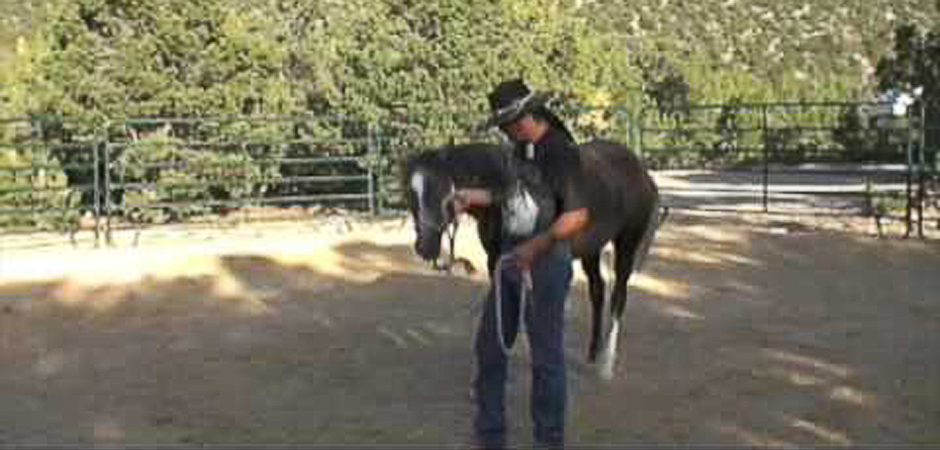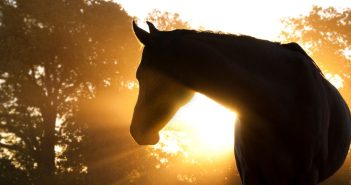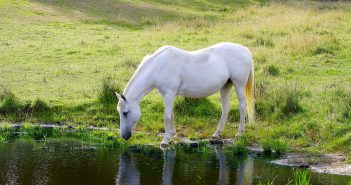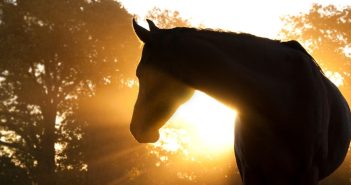by Eric Bravo
An important aspect of horsemanship training is getting and keeping the attention of your horse. A horse will focus on the leader of the herd for guidance. So-if your horse isn’t paying attention to you, then he is considering himself the leader. To succeed at horsemanship training, you need to be the leader-not your horse. Recently I got to see the benefits of keeping the attention of your horse in action.
Yesterday Sharon took her horse, Kelpie the Percheron mare, out for a walk on the road. I tagged along with Goose. We went for a walk as a sort of desensitization exercise since Kelpie is not used to being on the trail. Goose is quite spooky on the trail. I’ve ridden him a couple of times out there and got some practice using my emergency stop! Walking he did really good though and has actually come a long way toward being a more relaxed horse.
Watching Sharon with Kelpie gave us an opportunity to think about horse-human relations, dominance, and groundwork horsemanship training. Right off the bat Kelpie was doing two annoying things-she kept stopping to eat when we were walking along and would walk right past Sharon instead of keeping pace with her. Actually the latter is more than annoying since a horse that blows past you isn’t one that respects personal space making the horse dangerous to handle on the ground and unsafe to ride.
Sharon was bumping the horse pretty firmly with her lead rope when she would stop to eat, but the behavior just kept continuing. For the leading problem, I suggested Sharon throw in some stops and backing up when Kelpie would creep up on her, and to also change direction now and then. Sharon started doing this and was circling a lot in an effort to keep the horse from blowing past her.
This helped a little but the bad behavior continued. When we were stopped at one point Sharon was facing Kelpie, and I noticed that Kelpie was not looking at Sharon at all. This is a bad sign, if a horse you are working with is not paying attention to you with both eyes, that horse is not respecting you or looking to you for leadership. Kelpie was spending a lot of time looking at me, at Goose, and off in the field over to her left. But not a lot of time looking at Sharon.
When a horse is doing this you can make it uncomfortable for them to be directing their attention everywhere else but on you. You can do this by giving them a single bump with the lead rope every time they are looking off somewhere. The idea is to apply pressure that will bring the nose facing you so that you have the two eyes of the horse. You are facing the horse directly and suppose she is looking off to her left. Then you bump the rope in a sideways fashion to put pressure toward your left, which would be the right of the horse. If you’ve done it firmly enough this will encourage the horse to turn and look at you. Then you praise, either verbally or with a pet or both, but no treats!
Another good thing to do after you’ve got this down is to kind of walk back and forth in arcs in front of the horse. If the horse has decided your her leader, she will follow you with her eyes. If she hasn’t decided this, its a good opportunity to be bumping her nose toward you as you walk in this pattern.
Sharon spent some time practicing this but she is going to have to work at it to get that horse’s attention. I think she is also going to just have to get her energy up and be more firm with the horse. I asked if I could lead Kelpie for awhile, and I threw in some pretty firm backups and then Kelpie led real nice for me.
So anyway, the bottom line is you want your horse paying attention to you with both eyes when you’re working. If she isn’t doing so, she has her mind on something else other than you, like the coyote over in the next field. That isn’t a horse you want to be riding! You want a horse that you’re riding to be one that pays full attention to you.
Getting attention is a vital aspect of horsemanship training. We’re really training the person here and not the horse-he already knows to look at the leader of the herd for direction. What these exercises do is teach the person to become the leader of the herd for their own horse.
Eric lives in Albuquerque, New Mexico with his wife and two sons, Ruger, aged 8, and Kale, aged 6. He is available for in person clinics at request.





4 Comments
Very informative article, I have had trouble with my horse not paying attention, and spent lots of time in the round pen asking him to focus on me. It helped
Great stuff, you helped me out so much!
Thank you for this information!
Very good article, I have just been introduced to natural horsemanship and wonder why I never knew about it before. Amazing and so effective.